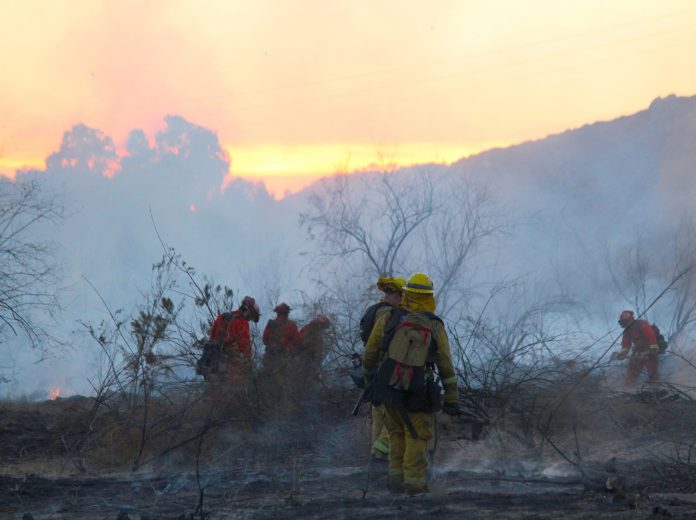
Various fire safety programs were approved by the San Diego County Board of Supervisors during the supervisors’ June 4 meeting.
The supervisors’ 4-0 vote, with Greg Cox at the National Association of Counties conference, directed the county’s Chief Administrative Officer to develop amendments for consideration to strengthen the county’s Fire Code and Building Code, directed the CAO to provide a budget change letter to add $1,570,119 of costs and five staff positions for vegetation management programs, amended the county’s Legislative Program to add support for legislation to facilitate environmental review of fire fuel management projects, and authorized a sole-source contract with Knox Company to allow emergency personnel to access gates.
“The goal of today’s action is to build communities that are more wildfire resistant,” said Supervisor Dianne Jacob.
The county has invested more than $500 million in fire and emergency services capabilities since the October 2003 wildfires, and in 2008 the Board of Supervisors and San Diego County’s Local Agency Formation Commission created the San Diego County Regional Fire Authority.
“It is imperative that we continue to enhance our firefighting capability,” said Supervisor Jim Desmond. “We’re getting better and better at preparing for fires and fighting the fires.”
On March 12 the county supervisors voted 5-0 to direct the CAO to work with the San Diego County Regional Fire Authority, the Sheriff’s Department, other county departments, and outside agencies to develop a plan to enhance protection against wildfires in existing and future communities and to return to the board within 90 days with recommendations.
“Disaster readiness is part of our culture,” said Ron Lane, the county’s Deputy Chief Administrative Officer who oversees the county’s Public Safety Group.
The CAO was directed to focus on five objectives: developing and implementing a more cohesive pre-fire strategy including expansion and increased support to fire safe councils, enhancing pre-fire vegetation management including the expansion of community chipping programs and working with agencies at all levels of government to develop a cooperative vegetation management plan including potential legislative changes to reduce or eliminate burdensome regulations for controlled burns and fire breaks, improving pre-fire emergency planning including enhancing existing technology and geographic information system (GIS) mapping for better protection of at-risk communities, strengthening fire safety measures in new construction including stricter building requirements in the Fire Code for buildings in high-risk areas, and reducing wildfire loss in existing structures including increased frequency of defensible space inspections and the development of a grant program to encourage fire-resistant building improvements.
Some of those are long-term projects while others will be completed in phases.
The June 4 action expands the SDCRFA’s Community Risk Reduction Division to assist up to 20,000 existing homeowners to achieve defensible space fire protection through community education and inspections, to work with industry and other stakeholders on a Building Code revision to require vents with resistance to flames and embers for new construction, to implement a community-level preparedness strategy for communities most at risk including protecting evacuation corridors and hardening existing structures as well as fuel management projects and public outreach, to provide a coordinated and comprehensive approach to vegetation management, and to improve pre-fire emergency planning through a multi-year effort to develop wildfire pre-plans for each community in unincorporated San Diego County.
The vegetation management approach will include expanding fuel breaks and prescribed burns as well as brush clearing along roadways, so environmental review and Air Pollution Control District approval will likely be required. The SDCRFA will also work with Federal, state, and other agencies on joint plans.
Community chipping programs will not require support from other agencies.
The community pre-fire prevention strategy will focus on four communities each year.
The SDCRFA will start with Crest and Guatay, and the first-year efforts will also include Palomar Mountain and the Lawson Valley area of Jamul. The communities will be prioritized based on the potential fire hazard, potential for loss, evacuation options, and community interest in preparedness.
“This approach will be done at a micro level: person by person, home by home, and community by community,” said SDCRFA fire chief Tony Mecham.
The cohesive pre-fire strategy elements will include holding community meetings and training through fire safe councils and the provision of educational materials, inspecting parcels, providing information on structure hardening including ember-resistant vents and ignition-resistant siding materials through in-person meetings as well as with written materials and on-line guidance, establishing a network of fuel breaks around communities to improve defensibility and tactical firefighting options as well as to reduce the risk of spreading the fire (72 acres around Guatay and 158 acres around Crest will be cleared; specific fuel breaks for the other communities are to be determined), working with the county’s Department of Public Works and the California Department of Transportation to remove hazardous vegetation along roadways, and collaborating with community groups to enhance mapping of corridors in and out of neighborhoods.
“The county’s going to be improving our firefighting capabilities community by community, neighborhood by neighborhood,” Desmond said.
During the first year of the program more than 2,500 parcels will be inspected in the four communities of focus.
Approximately 10,000 defensible space inspections in the unincorporated county were performed last year, and this year the county has a goal of 20,000 inspections.
“We’re doubling down on this inspection effort,” Jacob said.
At least 40 miles of county roads each year will be treated to ensure that evacuation is not impaired by vegetation.
Wildfire pre-plans will be prepared for each of the four communities addressed during the first year as well as for each community of focus during subsequent years.
The plans will provide responders with situational awareness on elements such as building designs, the location of water sources, and fuel breaks. The information will include the location of fire hydrants and which homes have cleared defensible space. The information will be included in the SDCRFA’s expanded GIS mapping.
The SDCRFA will also work with the Sheriff’s Department, the county’s Office of Emergency Services, and other agencies so that all fire and law enforcement personnel in the region are trained on the most current evacuation procedures.
The county’s Department of Planning and Development Services (PDS) updates the Building Code every three years.
PDS is currently drafting revisions which will cover attic and foundation ventilation and require vents with greater resistance to flames and embers. The revisions may also require additional roof eave protection and more protection for exterior siding materials.
The Fire Code is also updated every three years, and a requirement for a five-foot fuel modification zone around structures is being considered. The Building Code and Fire Code updates are expected to be considered by the Board of Supervisors in winter 2020.
Knox Company produces metal boxes which can be affixed to the sides of homes and allow emergency responders better access to at-risk individuals. The resident’s key is placed inside, and the boxes are accessed by a master key. Since there are no other brands of that product the sole source contract rather than a competitive bidding process was justified.
A fair and reasonable price will be determined before a five-year contract with Knox Company is issued.













